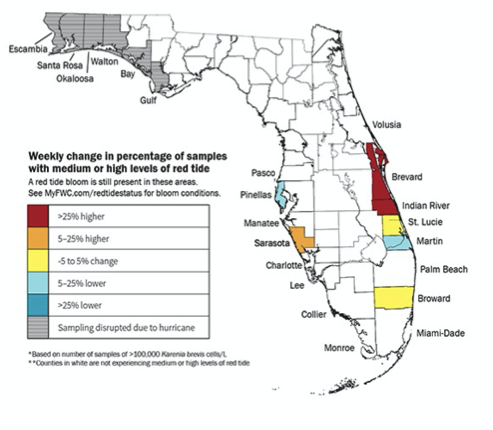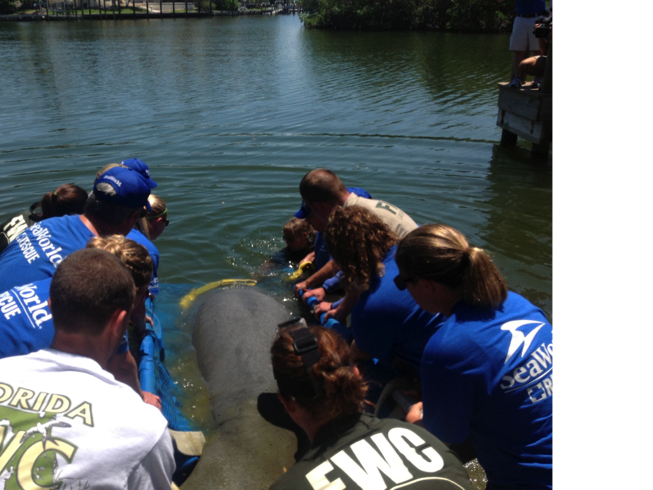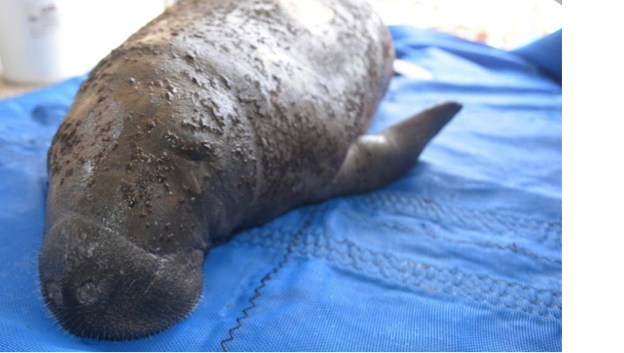The normal clear waters of Florida’s Gulf Coast have now become a muddy brown-red color and manatee deaths have taken a heavy toll because of it.
As of October of last year, the red tide, or harmful algae bloom, has had a higher-than-ever concentration and is still being tested for in Florida.

According to the National Oceanic and Atmospheric Administration (NOAA) the Florida red tide is also known as Karenia brevis or K. brevis for short produces toxins called brevotoxins. K. brevis has an effect on several marine animals including: fish, invertebrates like sea urchins, sea turtles, birds, dolphins, and manatees.
As of today, the manatee population is estimated to be at least 13,000 with Florida manatee population being 6,300 according to the Florida Fish and Wildlife Conservation Commission (FWC). A total of 540 manatees have been reported dead in the last eight months surpassing last year’s total of 538 due to the red tide.
There are three potential routes of how a manatee are exposed to the toxins of red tide. First, the churning of the sea and waves create an aerosol with toxins present, which the manatee breathes. Second, manatees can ingest toxic food. Third, and finally, the manatees can take in some seawater that contains the toxins.
“Algae becomes an issue when it settles on seagrass which is the primary food source for manatees,” said FWC spokesperson Kevin Baxter. “Once the algae are ingested, the manatees begin to have problems with their buoyancy and may have difficulty lifting their heads up.”
The Fish and Wildlife Research Institute (FWRI) has managed the Florida Manatee Rescue Rehabilitation and Release Reimbursement program for sick, injured and orphaned Florida manatees since 2000.

“When it comes to rescuing and treating sick manatees, earlier is better,” said Marine Mammal Trainer at Miami Sea Aquarium, Jillian Gonzalez. “If sick manatees are found in the first 24 hours of intoxication, they have a higher chance of making a full recovery.”
The Manatee Rescue and Rehabilitation Partnership (MRP) goal is to rescue sick and injured manatees, provide treatment at authorized rehabilitation facilities and release them back into the wild. The MRP gives manatees a second chance through a three-step process: rescue, rehabilitation, and release.
Manatee rescues are coordinated by the FWC. “The process of rescuing manatees involves multiple people,” said Marine Science Professor at Florida International University Jeremy Kisza, Ph.D. “Biologists throughout the state receive reports of distressed manatees via the 24-hour wildlife hotline and once a rescue is seemed necessary, staff will get out there as soon as possible.”

Once manatees have been rescued, they are then taken to one of the three facilities in Florida designated for manatee rehabilitation: Tampa Lowry Zoo, Miami, Sea Aquarium, and SeaWorld of Florida.
At this time, “Miami Sea Aquarium does not have any manatees that are suffering or recovering from red tide,” said Miami Sea Aquarium Senior Account Executive Maritza Arceo-Lopez.”
However, Tampa Lowry Zoo has currently rescued 16 manatees and saved 15 of them due to red tide. SeaWorld Orlando has rescued 22 manatees and saved 20 of them.
“Here at the manatee critical center in Zoo Tampa at Lowry Park, we have a 16,000-gallon critical care pool, two underwater treatment pools, as well as a public observation area,” said Director of Communications for Zoo Tampa Andrea Alava. “Even then though, we can only house six manatees comfortably so only so many manatees can be rescued, rehabilitated and released.”
According to the U.S. Fish and Wildlife Services, the West Indian Manatee recently went from endangered to threatened. However, the Florida red tide accounts for about 10 percent of the manatee deaths in the last decade. Due to the current algae bloom, that number can jump to 30 percent if the red tide continues in the future. Manatees are at a high risk of becoming extinct.
The Florida red tide bloom is continuing without much further predictions of its duration. “The need for a better treatment is underscored by the current, long-lasting bloom of Florida red tide and its intense impact on Florida manatees,” said Cathy Walsh, a marine immunology expert at Mote’s Labs. “With the current red tide bloom being the worst the state has endured since 2005, the situation is critical.”































